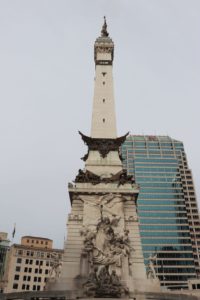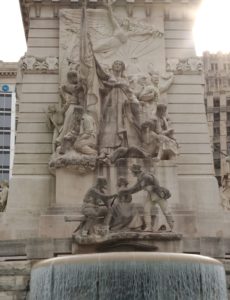

Located in the middle of Indianapolis, the Soldiers and Sailors Monument occupies a centered circular space first designated by the city’s architect Alexander Ralston for the Governor’s Mansion.[1] Written in celebration of the 150th anniversary of the establishment of the city of Indianapolis, The Circle: The Center of Indianapolis, by Ernestine B. Rose, tracks the uses of the Circle from Ralston’s inception to its current use as a war memorial site and a central downtown gathering space.[2] After several First Ladies refused to live in the home, citing privacy issues, the site was cleared and became a city park.
After the Civil War, veterans sought to honor their fallen comrades. After rejecting other sites including Crown Hill Cemetery, located four miles out of downtown, construction of the monument began here in 1888. The Bruno Schmidt design took 13 years to complete and the monument, which came to represent veterans of all five wars between the American Revolution and the Civil War was dedicated in 1902.[3] The Indiana limestone structure which stands 285.5 ft (87 m) tall, was the first in the nation to honor the common veterans. George Brewster’s 30 ft. (9.1m.) bronze, entitled Victory (also known as Indiana), tops the obelisk-style building. Sculpted scenes, entitled War, Peace, The Dying Soldier, and the Return Home, by Rudolph Swartz surround the base of the monument.
Completed in 1902, the $600,000 project had taken twelve years to build. The master of ceremony for the monument dedication on May 15th was General Lew Wallace, Hoosier Civil War veteran and the noted author of Ben-Hur. Hoosier Poet James Whitcomb Riley wrote and read a poem entitled The Soldier.[4] The Messiah of the Nations, a John Philip Sousa hymn, composed for the occasion, was played.[5] Several thousand members of GAR attended the event and marched around the Circle. The last surviving member of the GAR was honored at an on-site ceremony on August 29, 1949.
The unique structure became a symbol of the city, and its design features in many Indianapolis area logos. Each year, since 1962, the structure is draped with lights, and it becomes the World’s Largest Christmas Tree. Many downtown festivals are set on the Circle, and several parades and marathons include a loop around the Circle as a part of their paths The iconic nature of the monument, as well as its central location, makes it the most visited site in Indianapolis.
[1] Alexander Ralston. “Plat of the town of Indianapolis,” Indiana Historical Society, (Indianapolis. 2004) https://images.indianahistory.org/digital/collection/dc007/id/23.
[2] Ernestine Bradford Rose, The Circle: The Center of Indianapolis. (Indianapolis: Crippin Printing Corporation. 1971)
[3] Soldiers and Sailors Monument, Indiana Architecture Foundation, October 24, 2018, Accessed September 4, 2020, https://www.architectureindiana.com/?p=46159.
[4] James Whitcomb Riley, The Soldier. Poetry Nook, https://www.poetrynook.com/poem/soldier-16.
[5] John Philip Sousa (composer), James Whitcomb Riley (lyricist), “Messiah of the Nations,” Notated Music, (John Church Company. Cincinnati: Library of Congress): Accessed October 12, 2020, https://www.loc.gov/resource/sousa.200028299.0/?sp=2.